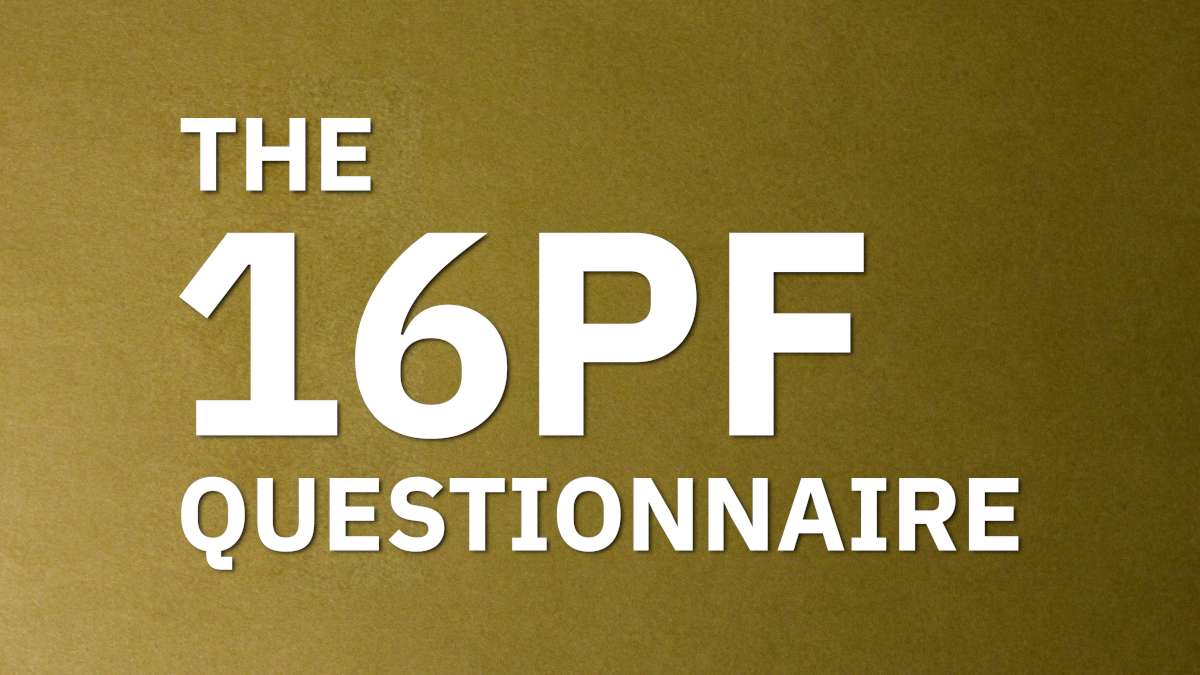The Sixteen Personality Factor Questionnaire, or 16PF for short, is a self-report personality test that helps uncover central dimensions within the normal personality sphere. To elaborate, we can describe these dimensions using a subset of adjectives of the English language.
Based on the lexical and factor analysis studies, the test comes in a multiple-choice questionnaire and assesses 16 primary factors of the personality, in terms of adjustment, and emotional stability. At the same time, it sheds light on potential anxiety problems and other behavioral issues.
Cattell’s internationally acclaimed 16PF questionnaire is widely used today by professionals, all over the world; from psychologists and mental health experts to career consultants, recruiters, and other HR professionals.
A bit of history
In the 1940s, Raymond Cattell and his team started searching for the underlying personality traits that make up a person. After several decades of research, using several scientific studies and techniques — such as the factor analysis method and psycolexical studies — they developed the 16PF test which measures 16 fundamental personality trait constructs.
As radical as it might have been considered back then, Cattell’s research directly suggested that the essence of personality is encoded within the language; in particular, adjectives. Starting with the Allport and Odbert list of adjectives of the English language, Cattell and his team managed to narrow them down to a taxonomy of 16 observable and factor-analyzed dimensions that offer an all-embracing description of an individual’s character.
What’s more, Cattel’s quantitative approach and groundwork study into traits, contributed to the formation of later personality trait models, such as the Big Five model; one of the most commonly used personality assessment methods.
What does the 16PF measure?
Essentially, the 16PF personality test evaluates a personality on two levels of traits. According to the creators of the 16PF, personality structure is hierarchical, unfurling into interconnected primary and secondary traits. We refer to them as Primary Scales and Global Scales, respectively.
Primary Scales
A. Warmth: outgoing, caring, attentive to others versus reserved, impersonal, detached
B. Reasoning: abstract-thinking, higher mental capacity versus concrete-thinking, lower mental capacity
C. Emotional Stability: mature, adaptive, emotionally stable versus reactive, changeable, affected by emotions
E. Dominance: dominant, forceful, assertive, competitive versus differential, accommodating, docile, cooperative
F. Liveliness: lively, spontaneous, enthusiastic, cheerful, expressive, impulsive versus serious, restrained, taciturn, careful, introspective
G. Rule-Consciousness: rule-conscious, dutiful, conscientious, conforming, moralistic, staid, rule-bound versus expedient, nonconforming, disregards rules, self-indulgent
H. Social Boldness: socially bold, venturesome, uninhibited versus shy, threat-sensitive, timid, hesitant
I. Sensitivity: sensitive, aesthetic, intuitive, refined versus utilitarian, objective, unsentimental, self-reliant, rough
L. Vigilance: vigilant, suspicious, skeptical, oppositional versus trusting, accepting, unconditional, easy
M. Abstractedness: abstract, imaginative, absentminded, impractical, absorbed in ideas versus grounded, practical, prosaic, solution-oriented, conventional
N. Privateness: private, discreet, polished, worldly, diplomatic versus forthright, genuine, artless, open, naive, unpretentious, involved
O. Apprehension: apprehensive, self-doubting, worried, insecure, worrying, self-blaming versus self-assured, unworried, complacent, secure, confident, self-satisfied
Q1. Openness to Change: open (to change), experimental, liberal, analytical, freethinking, flexible versus traditional, attached to familiar, conservative, respecting traditional ideas
Q2. Self-Reliance: self-reliant, solitary, resourceful, individualistic, self-sufficient versus group-oriented, affiliative, dependent
Q3. Perfectionism: perfectionist, organized, compulsive, self-disciplined, precise, self-sentimental versus disorder-tolerating, abstract, flexible, undisciplined, impulsive, careless
Q4. Tension: tense, high-strung, impatient, driven, frustrated versus relaxed, placid, patient, composed, unmotivated
Global Scales
We can group the Primary Scales in clusters of the following secondary traits, known as Global Scales:
- Extraversion: extraverted, outgoing, socially participating versus introverted, reclusive, socially-inhibited
- Anxiety: anxious, stressed, perturbable, versus calm, undisturbed, collected, well-adjusted
- Tough-Mindedness: tough-minded, resolute, non-empathetic versus receptive, open-minded, intuitive
- Independence: independent, persuasive, willful versus accommodating, agreeable, selfless
- Self-Control: self-controlled, inhibits urges versus unrestrained, follows urges
The 16PF assessment provides scores of the traits mentioned above, adding up to an overview of the personality profile of an individual. In addition, the Global Scales represent the core traits, which, in fact, are also available in the Big Five model — with a few variations.
The 16PF applications
The 16PF questionnaire is mainly used by professionals who aim to evaluate a person’s character, for various purposes. For instance, when used by psychologists and other mental health scientists, the 16PF serves as a clinical instrument for diagnosis, prognosis and, of course, therapy for mental health issues.
In addition, the 16PF Questionnaire is a valuable tool for HR professionals who make the most of its insights to assess and filter candidates; in an effort to find the ideal matches for specific job roles. The 16PF is also commonly used by counselors and consultants. They may provide vocational guidance and help predict whether an individual’s personality is suitable for a job profile; and vice versa.
How reliable is the 16PF test?
As a scientific tool, the 16PF displays a long record of validation evidence. Besides, it is supported by more than 60 published studies; and, over the years, the original study has been refined and updated.
In particular, the first release has been revised four times and was re-standardized in 2002. Notwithstanding, the initial list of personality traits, describing the personality profile of an individual, has remained the same over the last 50 years of research.
The test has been internationally established as an objective personality assessment tool; and extensively used as such, all over the world. As a matter of fact, it has been translated — and culturally adapted — into more than 35 languages.
Advantages of the 16PF assessment method
The 16PF personality test is an easy-to-use personality assessment tool for both administrators and examinees. On one hand, from the scope of test-takers, the plain and unambiguous language of the questionnaire makes it easy for them to understand; thus, offers a clear and relative reply in each section.
On the other hand, administrators can easily analyze the produced reports and use them for their pertinent purposes. Due to their clarity and straightforwardness, the 16PF reports can also prove useful to business executives, as well.
Another important characteristic of the 16PF personality test is that the desirable traits are never evident to the test-taker; hence, it’s difficult to steer results in a specific direction.
Instead of asking individuals to describe their personality using adjectives, the 16PF requires them to describe, for example, how they would react in daily hypothetical scenarios. Moreover, it might ask them to express opinions, and even state their interests.
This way, it guides respondents to disclose aspects of their personality subtly and indirectly. Because of the non-judgemental declarative questions that one can use throughout the test, the respondents don’t answer defensively; quite the opposite, they feel free to answer openly and distinctly. Therefore, the test helps uncover traits that shape the unique personality of each individual.
The 16PF in the workplace
Although it was a team of psychologists that developed and, at least initially, used the 16PF, today, it also brings value to career counselors and HR managers. In fact, in recent years, many scientifically accredited personality assessment tools, like the 16PF, have gained ground in the business world, as effective ways to hire the right person for the job through their HR processes.
Above all, the 16PF uncovers basic traits of the human personality, assisting recruiters and HR professionals to proceed with data-based — and, in a sense, risk-safe — decisions. That is to say, they can make suitable hires, based on the applicants’ personality profiles.
Striking the best person-job fit — at least in the majority of hires — HR professionals can help a company reduce employee turnover, increase employee performance, and improve teamwork; in the long run, even increase the company’s profitability, improving its bottom line.
What’s more, HR managers can use the 16PF to offer targeted counseling and plan customized training programs; contributing not only to the development of individuals but also the growth of businesses.
The assessment process
Leaving behind the old-fashioned, on-paper, and by-hand method, an online version of the 16PF test helps recruiters conduct the assessment process easier and faster. As a result, they can:
- Automate the process
- Send notifications to the examinees
- Evaluate the results much more effectively; and
- Save them for future reference
More often than not, examinees have to complete the 16PF test without any time limit. However, in most cases, the average time to complete this self-administrative test is 30-45 minutes.
As for the interpretation stage, there are many reports — also available online — that offer useful insights into efficiently interpreting results. Other than that, there is also an extensive bibliography on the 16PF assessment method that can help administrators with the evaluation process.
TL;DR
When in the process of hiring, highly researched and reliable personality assessment tools like the 16PF questionnaire offer clarity, precision and, overall, contribute to successful outcomes in hiring. The 16PF personality test allows recruiters to efficiently discover core behaviors in candidates that are key to performing well in specific roles within a company; not to mention, smoothly blending in the company culture.
Going a step further, with the insights collected by the 16PF profiling, professionals can hearken to each person’s professional need and potential, for progress and development. Today, more than ever, skillful HR professionals have the right tools, ready at hand, to bring about positive changes in the lives of people; and the growth of businesses alike.



